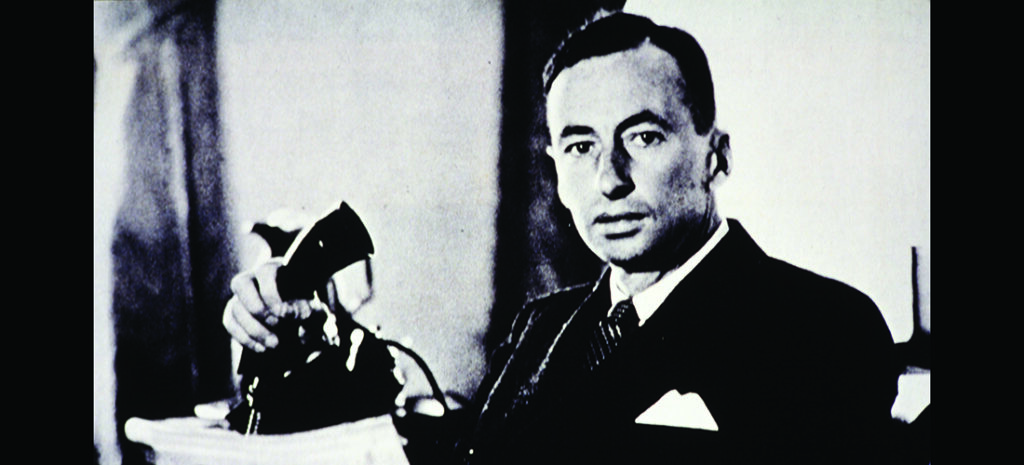Burlington Industries Celebrates a Centennial (1923–2023)

Following the thread of a financial genius
By Ross Howell Jr.
Featured Photo: J. Spencer Love (1896-1962) parlayed used equipment from his grandfather’s cotton mill into the largest textile manufacturing company in the world.
Workers commenced production at Burlington Mills Corp. in 1924, before construction of the building was even finished. Only half of the weave room had a floor, while the rest was earthen. Entrepreneur J. Spencer Love had chartered the company on November 6, 1923, naming it in tribute to the town where it would be located. The plant in Burlington would eventually employ some 200 workers.
Burlington Mills first produced all-cotton textiles, including flag cloth, bunting, curtain and dress fabrics, plus diaper cloth. But sales of cotton goods were declining. Spencer Love decided to experiment with a fiber called rayon — relatively unknown to American households. Rayon is made from purified cellulose, harvested primarily from wood pulp, which is then chemically converted. Right out of the gate, Burlington’s rayon bedspreads were a runaway success, facilitated by Love’s commitment to a world-class truck fleet for delivering products.
In 1935, Love (standing under the portico, wearing a light-colored overcoat) decided to move the company from its Burlington headquarters to Greensboro — primarily to take advantage of better rail transportation to New York City, where the company had opened a sales office in 1929, the year of the stock market crash. As America sank into the Great Depression, Burlington Mills kept growing, buying and reopening many of its competitors’ shuttered mills. Love’s strategy of growth through acquisition continued after the Depression and made the company an industry giant. Fred Rogers, Friendly Acres, remembers: “For a decade starting about 1990, I worked in the Burlington House division of Burlington Industries. That division had offices at 1345 Avenue of the Americas in New York City and in the town of Burlington, just down the street from the pioneer plant, where Spencer Love had built his first mill in a cornfield. A lot of people think of Love as a manufacturing man, but he was, in fact, a financial man. I’d say he was one of the earliest and best financiers in America, because he grew his company by acquisition. He was a financial genius.”
Men in skivvies? Burlington operations took a sharp turn in 1941, when the U.S. entered World War II. Burlington shifted to wartime production of more than 50 products for the armed forces, while the company’s research laboratories developed parachute cloth woven with a new fiber — nylon, a thermoplastic usually made from petroleum. Postwar, Burlington developed an array of clothing and home goods. Magazine ads featuring GIs gave way to TV ads with a “dancing man” wearing Burlington socks or stars such as singer Petula Clark and actor Robert Morley as spokespersons for the brand — along with a new corporate name, Burlington Industries.
Founder J. Spencer Love directed bold innovations during his nearly 40 years as president, but died unexpectedly at the age of 65 in 1962, the year Burlington Industries surpassed $1 billion in annual sales and became the first textile company in history to achieve that goal. In the 1960s, Burlington was the parent corporation for 17 constituent companies comprising more than 100 plants that manufactured products ranging from ribbon and suit fabrics to hosiery and carpets.
Retired schoolteacher Jane Gallimore, Fisher Park, remembers: “My family was living upstairs in the funeral home in Burlington my father owned. I was 10 years old. We’d driven over to Kirkwood to visit my aunt. Spencer Love’s death was in all the newspapers and my aunt suggested we drive by the house, just to see what was going on. I remember the house being on Sunset Drive. It had a circular driveway and we watched cars enter, dropping people off. I remember seeing butlers wearing white coats and white gloves meeting the cars and escorting guests inside. That sight has stayed with me all these years.”
In 1971, Burlington Industries built a new headquarters in Greensboro. The six-story structure featured an award-winning architectural design and was located on an expansive campus on Friendly Avenue. Its massive, crisscrossing steel trusses were said to represent the warp and weft of the fabric that created Burlington Industries’ great wealth. But for many people, they were a huge eyesore. The building was demolished in 2005 to make way for Friendly Center Shopping Center. Delores Sides, Summerfield, remembers: “Twenty-nine years ago I began work at Burlington Industries in the Rockingham plant. During the boom years, the company built a modern, glass-and-steel headquarters on Friendly Avenue. The structure won architectural awards, though everyone seemed to have an opinion about it, not always favorable. When the building was imploded in 2005, we watched from our new headquarters on Green Valley Road. We could glimpse the top of the building from our windows. There was a vibration, and then the top of the building was gone. It was the end of an era.”
After expending $2 billion over a 10-year period on a modernization initiative in the 1970s, Burlington Industries fended off a hostile takeover attempt in 1987 with a leveraged buyout, but was forced to file for Chapter 11 reorganization bankruptcy protection in 2001. While diminished from its heyday, Burlington Industries has been recapitalized and now manufactures high-tech fabrics at facilities in the Southeastern U.S., Mexico and China. Its offices were recently moved from Green Valley Road to — fittingly enough — beautiful, renovated facilities at Revolution Mill. OH
Freelance writer Ross Howell Jr. is grateful to Elevate Textiles, Inc., for its help with this article. For more information on Burlington Industries, visit www.elevatetextiles.com. On YouTube, you can find examples of vintage Burlington Industries TV ads, including the dancing man.
